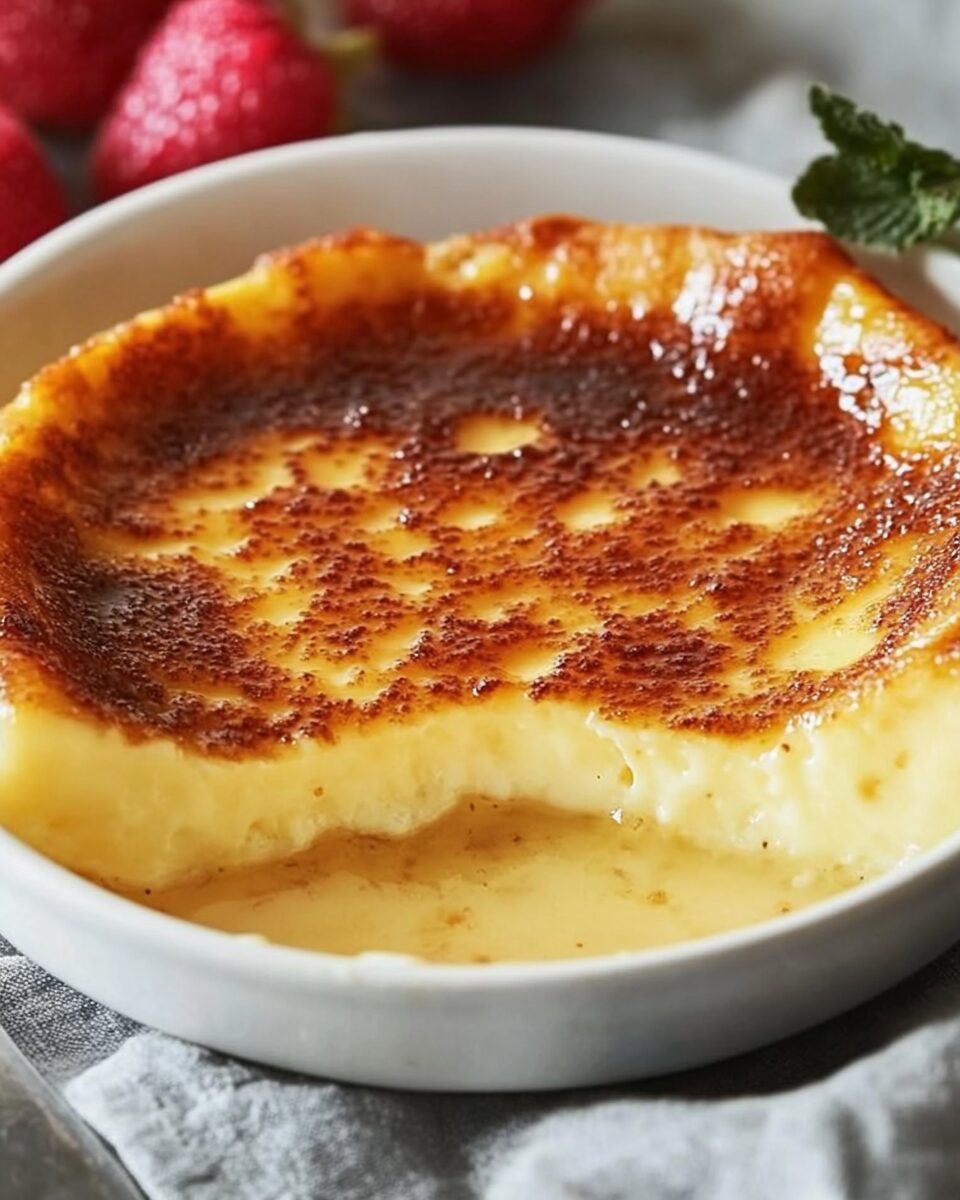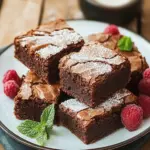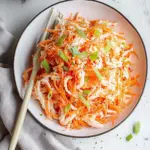This fail-proof egg custard boasts a velvety texture and a delicate vanilla flavor, making it a timeless dessert choice. The gentle baking process ensures a smooth consistency, while the optional nutmeg garnish adds a hint of spice.
Whether served warm as a comforting treat or chilled for a refreshing finish to a meal, this egg custard is versatile and always satisfying. Its simplicity and elegance make it a perfect addition to any dessert table or a delightful end to a family dinner.
Full Recipe
Ingredients:
-
5 large eggs
-
½ cup granulated sugar
-
1½ teaspoons vanilla extract
-
½ teaspoon salt
-
4 cups whole milk (or 2% milk)
-
Ground nutmeg (for garnish)
Directions:
-
Preheat your oven to 350°F (175°C). Lightly grease an 8×8-inch baking dish.
-
In a large mixing bowl, whisk together the eggs, sugar, vanilla extract, and salt until the mixture is smooth and the sugar has dissolved.
-
In a small saucepan, heat the milk over medium heat until it reaches about 180°F (82°C), just before it begins to simmer. Do not allow it to boil.
-
Gradually pour the hot milk into the egg mixture while continuously whisking to prevent the eggs from curdling. Once fully combined, whisk for an additional minute.
-
Pour the custard mixture into the prepared baking dish. If desired, sprinkle a light dusting of ground nutmeg over the top.
-
Place the baking dish into a larger baking dish or roasting pan. Carefully pour hot water into the outer pan until it reaches about 1 inch up the sides of the custard dish, creating a water bath.
-
Bake in the preheated oven for 45–50 minutes, or until a knife inserted into the center comes out clean. The custard should still have a slight jiggle in the center.
-
Remove from the oven and allow to cool slightly. Serve warm or refrigerate to chill before serving. Garnish with additional nutmeg or whipped cream if desired.
Prep Time: 15 minutes
Cooking Time: 45 minutes
Total Time: 1 hour
Kcal: Approximately 150 kcal per serving
Servings: 7 servings
Introduction to Egg Custard
Egg custard is a beloved classic dessert that has stood the test of time, offering a creamy texture, gentle sweetness, and comforting familiarity with every bite. With origins tracing back centuries, this timeless recipe is a staple in many cultures around the world. Whether served warm straight from the oven or chilled as a cool, refreshing treat, egg custard brings nostalgia and elegance to the table. It’s the kind of dessert that feels like a warm hug, evoking memories of homemade meals, family gatherings, and cherished traditions.
What makes this recipe so appealing is its simplicity. With just a handful of pantry staples—eggs, milk, sugar, vanilla, and a touch of nutmeg—you can create a luxurious dessert that’s both satisfying and sophisticated. This version is a baked custard, which creates a smooth, firm texture that slices beautifully while still melting in your mouth. The key lies in the gentle cooking process and the water bath, which ensures the custard cooks evenly without curdling or cracking.
The Origins and Cultural Importance of Egg Custard
Custard has a long and rich history, dating as far back as ancient Rome. The basic combination of eggs and milk has been used across Europe and Asia for centuries. In England, custard became a cornerstone of traditional desserts, from tarts to trifles, and was often flavored with spices like nutmeg and cinnamon. Meanwhile, in France, crème caramel and crème brûlée evolved from similar foundations, adding flair and depth to the humble custard base.
Egg custard’s versatility means it’s been embraced globally. In Chinese cuisine, a similar steamed egg custard is enjoyed both as a savory dish and as a dessert. In the United States, especially in the South, baked egg custard is a cherished dessert, often passed down through generations with family tweaks and secret touches.
This dish is not just about flavor—it’s about tradition, culture, and connection. Making custard from scratch can bring back family memories and introduce children and newcomers to the joy of homemade desserts.
Texture and Flavor Profile
The standout feature of this egg custard is its texture: a silky, smooth finish that melts on the tongue. This is achieved through careful preparation—gentle mixing, gradual heating, and the use of a bain-marie (water bath) while baking. The water bath plays a vital role by insulating the custard from direct heat, preventing it from becoming rubbery or overcooked.
Flavor-wise, the custard is delicately sweet, allowing the eggs and milk to shine. Vanilla extract adds aromatic depth, while a sprinkle of ground nutmeg on top introduces a subtle spice that enhances the overall profile without overpowering it. The result is a balanced dessert that appeals to both adults and children, with a comforting, old-fashioned charm.
Nutritional Considerations
While egg custard is undoubtedly a dessert, it offers some nutritional benefits that set it apart from many overly processed sweets. Eggs provide high-quality protein and essential nutrients like vitamin D, B12, and choline. Milk contributes calcium, potassium, and additional protein, making this dessert a bit more nutrient-dense than many alternatives.
For those watching their sugar intake or fat content, the recipe can be slightly adjusted. Low-fat milk can be used to reduce calories, though whole milk delivers the creamiest texture. Sugar alternatives like stevia or monk fruit sweetener can replace granulated sugar in moderation for a lower glycemic option.
However, because it contains dairy and eggs, it’s not suitable for those with specific allergies or dietary restrictions unless substitutions are made.
Serving Suggestions and Variations
One of the joys of egg custard is its flexibility. It can be served in a number of ways to suit different tastes and occasions. Warm custard is a comforting treat in colder months, especially when topped with a dollop of whipped cream or a drizzle of caramel sauce. When chilled, it becomes a light and refreshing summer dessert that pairs beautifully with fresh berries, a mint sprig, or a fruit compote.
For an elegant dinner party, consider baking the custard in individual ramekins for a refined presentation. Alternatively, a large dish of custard can be sliced and served family-style at casual gatherings or potlucks.
You can also experiment with different flavorings—adding a splash of almond extract, lemon zest, or even a hint of espresso. If you’re feeling adventurous, infuse the milk with lavender or chai spices before adding it to the egg mixture. These subtle changes can dramatically elevate the custard’s profile and make it uniquely yours.
Why This Custard is “Fail-Proof”
Many home cooks shy away from custard due to fears of curdling, cracking, or ending up with a runny mess. This “fail-proof” method is designed to remove that fear entirely. It walks a careful line between simplicity and technique, providing foolproof results as long as the instructions are followed with care.
By gradually combining the hot milk with the egg mixture and baking the custard in a water bath, you eliminate the most common pitfalls of custard-making. The result is a perfectly set, ultra-smooth texture every time.
Even if you’re a beginner in the kitchen, this recipe is approachable. No fancy equipment is required—just basic baking dishes, a whisk, and a gentle touch. Once you’ve mastered it, you’ll feel confident enough to experiment with additional flavors and techniques.
Storage and Shelf Life
Egg custard can be stored in the refrigerator for up to 3–4 days. It’s best kept covered to prevent it from absorbing any odors. If you plan to serve it cold, allow it to chill completely before covering with plastic wrap or transferring to an airtight container.
Custard should not be frozen, as the texture can break down upon thawing. Instead, enjoy it within a few days of making it. If you’re making it ahead of time for a special occasion, prepare it the day before for the best flavor and consistency.
Leftovers, if any, are perfect for breakfast with fruit or as an afternoon snack paired with tea or coffee.
Why It’s Still a Favorite in Modern Kitchens
In an age where dessert recipes often involve a long list of hard-to-find ingredients or complex steps, egg custard stands out for its simplicity and timelessness. It reminds us that sometimes, the best dishes are those with the fewest ingredients and the most love behind them.
It also fits well into today’s lifestyle trends—fewer processed foods, more comfort cooking, and reviving traditional recipes. It’s a nostalgic dessert that doesn’t feel outdated, proving that the classics never truly go out of style.
Families are rediscovering the value of homemade desserts, and egg custard is often one of the first recipes to make a comeback. Its gentle sweetness, simplicity, and reliability make it a staple worth keeping in every home cook’s repertoire.
Conclusion
Egg custard is a delightful dessert that continues to captivate with its silky texture, subtle sweetness, and elegant simplicity. Whether you’re a novice baker or an experienced cook, this fail-proof recipe provides a reliable and rewarding way to enjoy a time-honored classic. Its versatility, nutritional value, and universal appeal make it a perfect dessert for any occasion—quiet nights in, family dinners, or festive gatherings.
By mastering this recipe, you’re not just making dessert—you’re continuing a culinary tradition passed down through generations. And with just a few ingredients and a little care, you can turn your kitchen into a space where memories are made and comfort is served.






